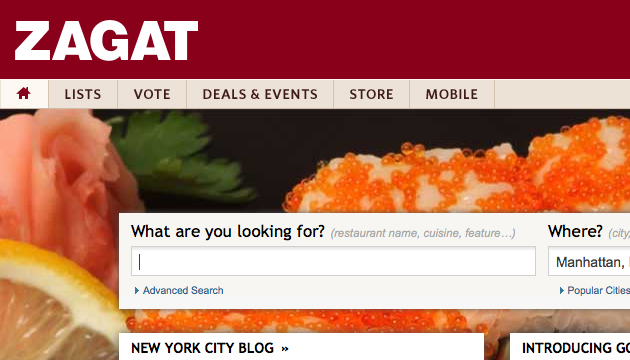Zagat: Crowdsourcing Pioneers


Will you do us the honor and join our team of authors?
To write for the SohoBlog, contact us at [email protected]
(Shakespearean prose not required.)

Crowdsourcing is considered to be something that has developed and caught on only in recent times. I even described it in a previous post as the third-generation job market. However, there is a company that has been using crowdsourcing for quite some time.
Zagat Survey, one of the most-used (if not the most-used) restaurant and lifestyle guides in the US, has been using crowdsourcing for over 40 years. The guide was established by Tim and Nina Zagat, who collected reviews about New York City restaurants from their friends and grouped the reviews together into a book. Nowadays, Zagat covers over 70 cities in the US, using reviews from millions of people to rate shopping, nightlife, movies, golf courses, and airlines.
It all started when the Zagats decided to create a standardized survey that would be diners’ most accurate and extensive source for New York restaurants. They came up with a 30-point-scale rating system that focuses on food, decor, service, and cost and also incorporates quotes from reviewers. At first, they were using low-tech crowdsourcing by passing down their survey to friends and friend of friends. Then, once people started using the Internet, it was much easier to reach millions of diners and ask for their reviews.
From the get-go, Zagat’s ideas and execution was innovative and novel. According to Nina Zagat, they “started doing something social, local and mobile before anyone saw any value in these things.” Mobile—because of the guide’s slim shape that can fit into a coat pocket. Local—because the guide focused on a specific area and managed to cover and review every restaurant the readers were interested in. Social—because Zagat relied on the social interactions of anonymous reviewers, who happily shared their local knowledge with other restaurant lovers.
The Internet made it that much harder for Zagat to differentiate itself from other free user-generated review sites such as Dine.com, Tripadvisor, Urbanspoon and, most importantly, Yelp.com. Faced with competition, Zagat took two drastic measures. First, Zagat got bought out by Google in September 2011. Even though Zagat is still an operating as an independent small business, the reviews are now incorporated into Google’s local offerings. Second, in July 2011 they introduced a new user interface called the Matrix. The Matrix is a graphical interface that helps users asses the relative value of restaurants around them. After adding considerations such as location, type of cuisine, and special features, to name a few, the Matrix reveals which restaurant, fitting the chosen criteria, gives the diners the best bang for their buck.
What I find the most interesting is that not much has changed for Zagat (except maybe technology). Then and now, the guide focuses on making information more accessible and relevant for restaurant-goers. Zagat’s pioneering spirit has allowed it to stay relevant and successful and get the upper hand in a very competitive market.
|
|
|